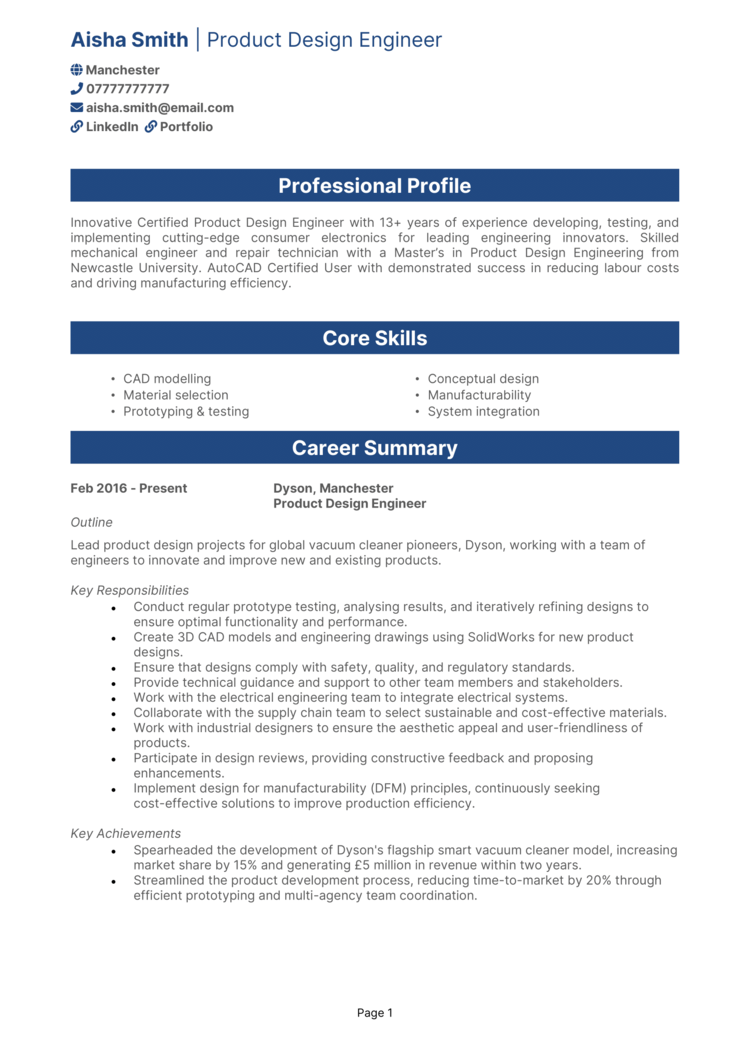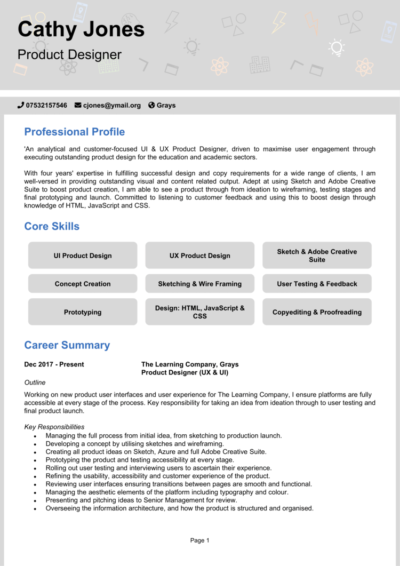Ready to design your next career move? Let’s make sure your CV is as sleek and functional as the products you create. Think of this guide as your creative brief – it’ll help you draft a good CV that’s impossible for recruiters to scroll past.
Your design portfolio tells a story, and so should your CV – this guide, with some detailed Product Designer CV examples, will help you showcase your skills, vision, and career wins, in order to land you the top design roles you deserve.
Product Designer CV

Product Design Engineer CV

How to write your Product Designer CV
Learn how to create your own interview-winning Product Designer CV with this simple step-by-step guide.
A Product Designer CV needs to balance creativity and technical expertise, demonstrating your ability to take products from concept to reality. Employers want to see your skills in user-centred design, prototyping, and collaboration.
This guide will teach you how to writing a CV that makes you stand out, secures interviews, and gets you closer to your next big design challenge.
Product Designer CV structure


As you know so well, no one wants to navigate a clunky layout: your CV needs to be as well-designed as the products you create. A strong CV structure will ensure hiring managers can quickly spot your qualifications and achievements instead of aesthetic mistakes.
Here’s how to structure your Product Designer CV:
- Name and personal details – Keep your contact details at the top so recruiters can easily reach you. Including a picture of yourself is optional.
- Profile – Start things off with a quick summary of your design expertise, technical skills, and career highlights.
- Core skills – Bullet point your abilities, such as user research, wireframing, and prototyping.
- Work experience – List off your past roles in reverse chronological order, focusing on key projects and contributions.
- Education – Show your academic background, design training, and relevant certifications.
- Additional info – In an optional section at the bottom, you can discuss things like your hobbies and interests and awards which show the right transferable skills.
CV format for a Product Designer


Your CV format should reflect the design principles you live by: clarity, functionality, and visual appeal. A professional, easy-to-read format ensures recruiters focus on your expertise.
Here’s how to format your Product Designer CV effectively:
- Bullet points – Use these to break down responsibilities and achievements for easy skimming.
- Divide sections – Clear headings help recruiters navigate your CV like a well-thought-out product journey.
- Use a clean font – Pick a professional font that mirrors your attention to detail.
- Keep it the right length – Two pages is the perfect length to cover the essentials without turning your CV into another cover letter.
Product Designer CV profie


Your profile (or personal statement for junior candidates) is like the landing page of a product – it needs to grab attention and instantly communicate value. It’s the key part in your CV, where you’ll show recruiters why you’re the designer they need to bring their vision to life.
Product Designer CV profile examples
Profile 1
Creative Product Designer with five years of experience designing user-centric digital products for the fintech sector. Skilled in UX/UI design, wireframing, and prototyping using tools like Figma and Sketch. Delivered solutions that improved user engagement through intuitive interfaces and seamless functionality.
Profile 2
Organised Product Designer with three years of experience creating consumer electronics for a technology company. Proficient in CAD software, prototyping, and conducting user testing to refine designs. Successfully launched three products to market, generating over £1M in revenue.
Profile 3
Experienced Product Designer with over eight years of expertise in designing sustainable products for the home goods industry. Adept at material selection, lifecycle analysis, and creating environmentally friendly solutions. Delivered designs that reduced manufacturing costs and met sustainability standards.
What to include in your Product Designer CV profile
Here are some tips on what to include in your Product Designer CV profile:
- Where you’ve worked – Note which sort of design studios, product teams, or freelance clients you’ve collaborated with.
- Your top qualifications – Highlight your degrees or certifications in design, such as industrial or UX design.
- Key expertise – Quickly list your biggest skills like user research, prototyping, or design software.
- Design specialisations – Note areas like interaction design, physical product development, or sustainability.
- Notable contributions – Include achievements like launching successful products or improving user experiences.
Core skills section


Your core CV skills section should spotlight the abilities that make you a standout product designer. Tailor this section to align with the role’s specific requirements, such as UX design, manufacturing, or software development.
Skills to include in a Product Designer CV
- User Research – Conducting interviews, surveys, and usability testing to understand user needs and behaviours.
- Wireframing and Prototyping – Creating low-fidelity wireframes and interactive prototypes using tools like Figma or Sketch.
- UI/UX Design – Designing user interfaces and crafting seamless user experiences that prioritise functionality and aesthetics.
- Visual Design – Applying typography, colour theory, and design principles to create visually appealing products.
- Design Systems – Building and maintaining cohesive design systems to ensure consistency across products.
- Interaction Design – Defining how users interact with a product through animations, transitions, and feedback loops.
- Responsive Design – Creating adaptable designs that work across various screen sizes and devices.
- Collaboration with Developers – Communicating design specifications and working closely with developers to implement designs effectively.
- A/B Testing – Running experiments to compare design variations and optimise user engagement.
- Agile Methodology – Working within Agile frameworks to iterate designs based on feedback and evolving requirements.
Work experience


Your work experience section is where you showcase your impact as a designer. Focus on your contributions to projects, collaboration with teams, and the results you achieved.
Always list roles in reverse chronological order, giving more detail to the most recent and relevant jobs.
How to structure jobs

- Outline – Provide a brief description of the company or client, your role, and the type of products you designed.
- Responsibilities – List your key tasks, such as conducting user research, creating prototypes, or managing design systems.
- Achievements – Show off measurable outcomes, like product launch success rates or customer satisfaction improvements. Use numbers wherever possible for the best impact.
Work experience samples for a Product Designer
Product Designer | FinEdge Digital Solutions
Outline
Designed user-friendly fintech products for a leading digital solutions provider, focusing on improving user engagement and satisfaction. Collaborated with cross-functional teams to deliver seamless digital experiences.
Responsibilities
- Created wireframes, prototypes, and high-fidelity designs using Figma and Adobe XD.
- Conducted user research and usability testing to gather insights and inform design decisions.
- Collaborated with developers to ensure accurate implementation of design specifications.
- Refined user interfaces to improve accessibility and compliance with WCAG standards.
- Presented design concepts to stakeholders, incorporating feedback to align with business goals.
Achievements
- Increased user engagement by 30 percent through optimised UX/UI designs.
- Reduced onboarding times by 20 percent with redesigned user flows.
- Recognised for delivering a flagship fintech app that exceeded download targets by 50 percent.
Product Designer | TechVision Solutions
Outline
Developed consumer electronics for a mid-sized technology company, focusing on innovative and functional designs. Delivered market-ready products that balanced aesthetics with user needs.
Responsibilities
- Designed product concepts and created detailed 3D models using SolidWorks and Rhino.
- Collaborated with engineers and manufacturers to refine designs for production.
- Led user testing sessions to gather feedback on prototypes and make data-driven improvements.
- Selected materials and finishes that enhanced product durability and visual appeal.
- Maintained documentation of design processes to ensure consistency and quality.
Achievements
- Launched three successful products that collectively generated over £1M in revenue.
- Improved product assembly efficiency by 15 percent through design adjustments.
- Praised by management for balancing innovation with manufacturability.
Product Designer | EcoHome Creations
Outline
Specialised in designing sustainable home goods for an eco-conscious brand, focusing on creating innovative, environmentally friendly products. Worked on the full product lifecycle, from concept to delivery.
Responsibilities
- Conducted lifecycle analyses to identify sustainable design opportunities.
- Created 3D models and renderings using Fusion 360 to visualise product concepts.
- Collaborated with suppliers to source eco-friendly materials and reduce waste.
- Led workshops to educate the team on sustainable design practices.
- Developed marketing materials showcasing the environmental benefits of new products.
Achievements
- Reduced manufacturing costs by 20 percent while maintaining sustainability standards.
- Designed a best-selling kitchen product that accounted for 25 percent of annual revenue.
- Received an industry award for innovation in sustainable product design.
Education and qualifications


The education section highlights your design training and academic foundation.
Include degrees, certifications, and relevant courses in product design, user experience, or industrial design. If you’re newer to the field, highlight coursework or personal projects that demonstrate your skills.
Always list qualifications in reverse chronological order, starting with the most recent.
Qualifications recruiters look for in a Product Designer
- Bachelor’s Degree in Product or Industrial Design – Provides foundational skills in designing and developing physical products.
- Master’s Degree in UX/UI Design – Demonstrates advanced knowledge in creating user-friendly interfaces.
- Human-Centred Design Certification – Highlights your ability to design with user needs in mind.
- AutoCAD Certification – Validates expertise in using industry-standard design software.
- Certified SolidWorks Professional (CSWP) – Demonstrates proficiency in 3D design and modelling tools.





